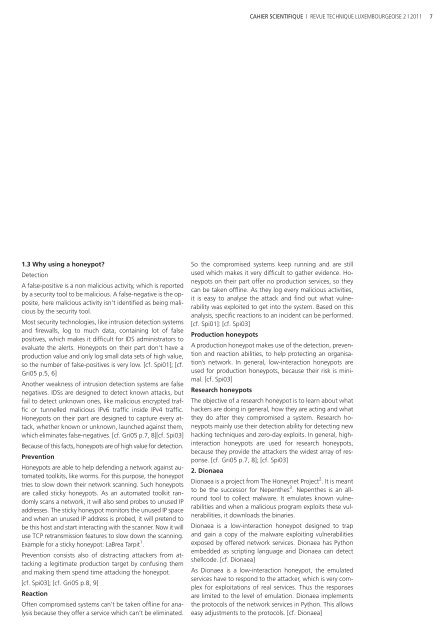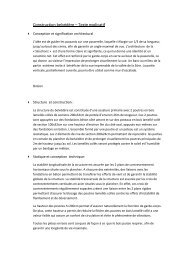Cahier Scientifique 02 | 2011 (PDF) - Revue Technique ...
Cahier Scientifique 02 | 2011 (PDF) - Revue Technique ...
Cahier Scientifique 02 | 2011 (PDF) - Revue Technique ...
You also want an ePaper? Increase the reach of your titles
YUMPU automatically turns print PDFs into web optimized ePapers that Google loves.
CAHIER SCIENTIFIQUE | REVUE TECHNIQUE LUXEMBOURGEOISE 2 | <strong>2011</strong><br />
7<br />
1.3 Why using a honeypot?<br />
Detection<br />
A false-positive is a non malicious activity, which is reported<br />
by a security tool to be malicious. A false-negative is the opposite,<br />
here malicious activity isn’t identified as being malicious<br />
by the security tool.<br />
Most security technologies, like intrusion detection systems<br />
and firewalls, log to much data, containing lot of false<br />
positives, which makes it difficult for IDS administrators to<br />
evaluate the alerts. Honeypots on their part don’t have a<br />
production value and only log small data sets of high value,<br />
so the number of false-positives is very low. [cf. Spi01]; [cf.<br />
Gri05 p.5, 6]<br />
Another weakness of intrusion detection systems are false<br />
negatives. IDSs are designed to detect known attacks, but<br />
fail to detect unknown ones, like malicious encrypted traffic<br />
or tunnelled malicious IPv6 traffic inside IPv4 traffic.<br />
Honeypots on their part are designed to capture every attack,<br />
whether known or unknown, launched against them,<br />
which eliminates false-negatives. [cf. Gri05 p.7, 8][cf. Spi03]<br />
Because of this facts, honeypots are of high value for detection.<br />
Prevention<br />
Honeypots are able to help defending a network against automated<br />
toolkits, like worms. For this purpose, the honeypot<br />
tries to slow down their network scanning. Such honeypots<br />
are called sticky honeypots. As an automated toolkit randomly<br />
scans a network, it will also send probes to unused IP<br />
addresses. The sticky honeypot monitors the unused IP space<br />
and when an unused IP address is probed, it will pretend to<br />
be this host and start interacting with the scanner. Now it will<br />
use TCP retransmission features to slow down the scanning.<br />
Example for a sticky honeypot: LaBrea Tarpit 1 .<br />
Prevention consists also of distracting attackers from attacking<br />
a legitimate production target by confusing them<br />
and making them spend time attacking the honeypot.<br />
[cf. Spi03]; [cf. Gri05 p.8, 9]<br />
Reaction<br />
Often compromised systems can’t be taken offline for analysis<br />
because they offer a service which can’t be eliminated.<br />
So the compromised systems keep running and are still<br />
used which makes it very difficult to gather evidence. Honeypots<br />
on their part offer no production services, so they<br />
can be taken offline. As they log every malicious activities,<br />
it is easy to analyse the attack and find out what vulnerability<br />
was exploited to get into the system. Based on this<br />
analysis, specific reactions to an incident can be performed.<br />
[cf. Spi01]: [cf. Spi03]<br />
Production honeypots<br />
A production honeypot makes use of the detection, prevention<br />
and reaction abilities, to help protecting an organisation’s<br />
network. In general, low-interaction honeypots are<br />
used for production honeypots, because their risk is minimal.<br />
[cf. Spi03]<br />
Research honeypots<br />
The objective of a research honeypot is to learn about what<br />
hackers are doing in general, how they are acting and what<br />
they do after they compromised a system. Research honeypots<br />
mainly use their detection ability for detecting new<br />
hacking techniques and zero-day exploits. In general, highinteraction<br />
honeypots are used for research honeypots,<br />
because they provide the attackers the widest array of response.<br />
[cf. Gri05 p.7, 8]; [cf. Spi03]<br />
2. Dionaea<br />
Dionaea is a project from The Honeynet Project 2 . It is meant<br />
to be the successor for Nepenthes 3 . Nepenthes is an allround<br />
tool to collect malware. It emulates known vulnerabilities<br />
and when a malicious program exploits these vulnerabilities,<br />
it downloads the binaries.<br />
Dionaea is a low-interaction honeypot designed to trap<br />
and gain a copy of the malware exploiting vulnerabilities<br />
exposed by offered network services. Dionaea has Python<br />
embedded as scripting language and Dionaea can detect<br />
shellcode. [cf. Dionaea]<br />
As Dionaea is a low-interaction honeypot, the emulated<br />
services have to respond to the attacker, which is very complex<br />
for exploitations of real services. Thus the responses<br />
are limited to the level of emulation. Dionaea implements<br />
the protocols of the network services in Python. This allows<br />
easy adjustments to the protocols. [cf. Dionaea]

















